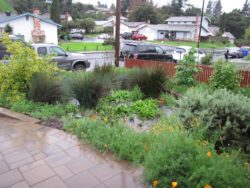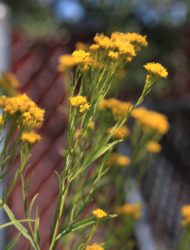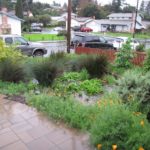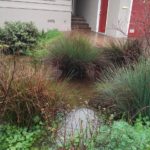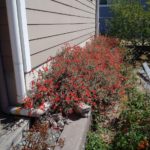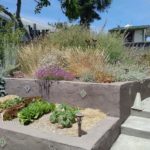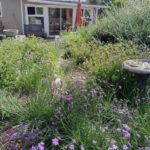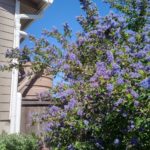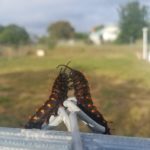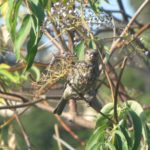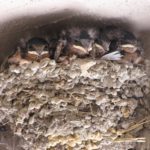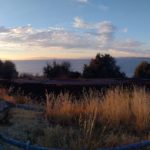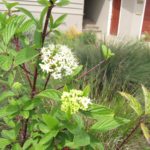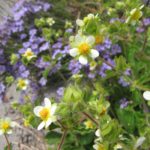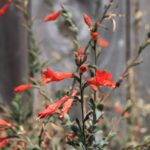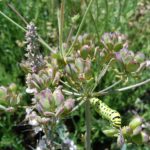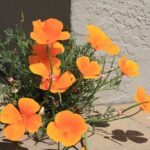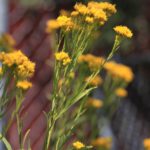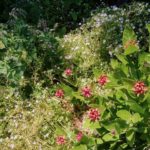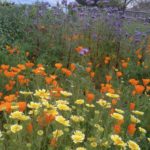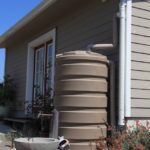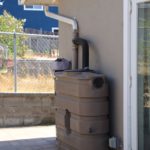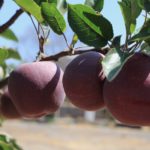Lot size: 670 sq. ft. front and 5,000 sq. ft. back gardens, 90% native, 10% edibles
Garden Age: Garden was installed in stages, beginning in 2012
Years on the Bringing Back the Natives Garden Tour:
Showcase Feature
Rolland and Jen worked in the field of environmental restoration for decades. When they bought this house, in 2011, they were eager to remove the plastic sheeting that covered the front garden, and the weeds that had engulfed the back.
In this large, sunny, hot, and windy garden, which Jen and Rolland designed and installed themselves, they chose mostly local native plants that are straight species—plants descended from plants that have grown in the Bay Area, naturally, for eons—though some cultivars were included in this garden to better deal with clay soil and narrow spaces. (In contrast, cultivars are genetically-identical selections or hybrids developed by horticulturalists to select for specific characteristics, such as flower size, leaf color, or compactness of growth. See the this interesting article for more information on cultivars and straight species.)
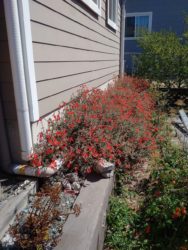 In the front garden a retention basin was created to retain rainwater captured from the roof and patio, and the overflow from five rain barrels. The basin is planted with blue elderberry, rushes, and dogwood, which can tolerate both wet and dry conditions. In the summer and fall the swale’s edges are brightened with the blossoms of cream-colored buckwheats, bright red fuchsia, and the spectacular yellow of our California goldenrod. Retaining rainwater on-site gives plants a long, deep drink during the winter and spring, and keeps the garden green longer. In addition to conserving water and benefitting the plants, retaining rainwater on-site also reduces the flow of contaminants from the street to nearby San Pablo Bay, and helps to replenish groundwater.
In the front garden a retention basin was created to retain rainwater captured from the roof and patio, and the overflow from five rain barrels. The basin is planted with blue elderberry, rushes, and dogwood, which can tolerate both wet and dry conditions. In the summer and fall the swale’s edges are brightened with the blossoms of cream-colored buckwheats, bright red fuchsia, and the spectacular yellow of our California goldenrod. Retaining rainwater on-site gives plants a long, deep drink during the winter and spring, and keeps the garden green longer. In addition to conserving water and benefitting the plants, retaining rainwater on-site also reduces the flow of contaminants from the street to nearby San Pablo Bay, and helps to replenish groundwater.
The large back yard contains a diverse mix of unirrigated local native plants—including a restoration-focused native grassland—as well as fruit trees and raised vegetable beds that use a simple drip irrigation system or are hand-watered with rainwater. A raised berm along one fenceline was planted early on with manzanita, California lilac, madrone, and a locally-collected buckeye. The other fenceline was planted in 2022 with more common natives such as coyote bush, coffeeberry, buck brush, and desert olive. The large shrubs act as a beautiful privacy screen, while also providing habitat and a variety of food for wildlife.
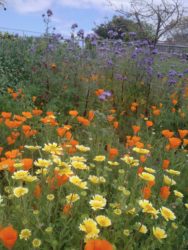 Among the plants lining the paths in the back garden are sticky cinquefoil, buckwheats, fuchsia, June grass, yarrow, and seaside daisy. Poppies and yarrow sprout exuberantly between pieces of the former patio and driveway, which have been cut, re-laid, and are enjoying new lives as a pathway and raised garden bed retaining walls.
Among the plants lining the paths in the back garden are sticky cinquefoil, buckwheats, fuchsia, June grass, yarrow, and seaside daisy. Poppies and yarrow sprout exuberantly between pieces of the former patio and driveway, which have been cut, re-laid, and are enjoying new lives as a pathway and raised garden bed retaining walls.
Other Garden Attractions
• The native plants in this garden are not watered after they are established.
• In the back garden a scrub jay planted an oak in “the perfect spot”; though still small, the oak will provide shade and structure to the garden when it has matured.
• Compost bins create beautiful soil amendments from kitchen and garden waste, and compost is applied to veggie beds annually. The veggie beds are mulched with rice straw to conserve water and keep weeds down.
• 1,000 gallons of water are stored in 5 rainwater tanks. Now that most of the garden is well-established and no longer requires hand-watering, the stored rainwater provides most of the irrigation needed for the vegetable gardens through the summer.
Gardening for Wildlife 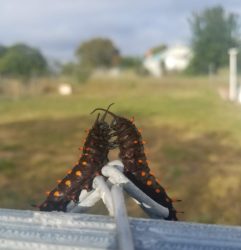
Iridescent blue pipevine swallowtail butterflies lay eggs on the Dutchman’s pipevine, the only host plant for this beautiful butterfly. Lorquin’s admiral, gray hairstreak, and anise swallowtail butterflies and white-lined sphinx moths also flutter about, nectaring on the more than eighty species of native plants found in this wildlife-friendly garden.
Hummingbirds, white-crowned sparrows, Western bluebirds, red-breasted nuthatches, hooded orioles, black phoebes, and oak titmice have been seen in the garden; barn swallows nest here every year. The birds are attracted by dried seed heads, which are left on the plants well after the blossoms are spent, berries. Leaf litter and smaller prunings are left in place or added to small brush piles to support insects and provide shelter for small creatures. Once-annual winter pruning to refresh or reshape larger plants is used as erosion control mulch on a rear slope, where railroad vegetation-clearing and wildlife digging has foiled most attempts to establish plants.
Keystone species in this garden (watch this talk by Doug Tallamy!)
Keystone species—our own, local ecological powerhouse plants—in this garden include: holly leafed cherry, oak, California lilac, manzanita, buckwheats, goldenrod, asters, sages, currants, and creambush.
Wheelchair Access? yes
Green Home Features (Click for details.)
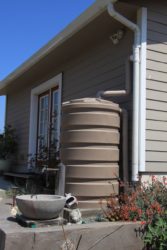 The metal roof is fire-resistant, made of recycled metal, and recyclable at the end of its life; there is a white Cool Roof on the sun room. Solar panels provide most of the energy the household uses.
The metal roof is fire-resistant, made of recycled metal, and recyclable at the end of its life; there is a white Cool Roof on the sun room. Solar panels provide most of the energy the household uses.
Denim insulation, which meets or exceeds ASTM testing for batt insulation, contains no chemical irritants, and is made both made from 80% post-consumer recycled natural fibers and is recyclable, was used to insulate the house.
The back deck was built with Trex recycled plastic decking, and the outdoor furniture is Polywood—made from landfill-bound and ocean-bound plastic.


